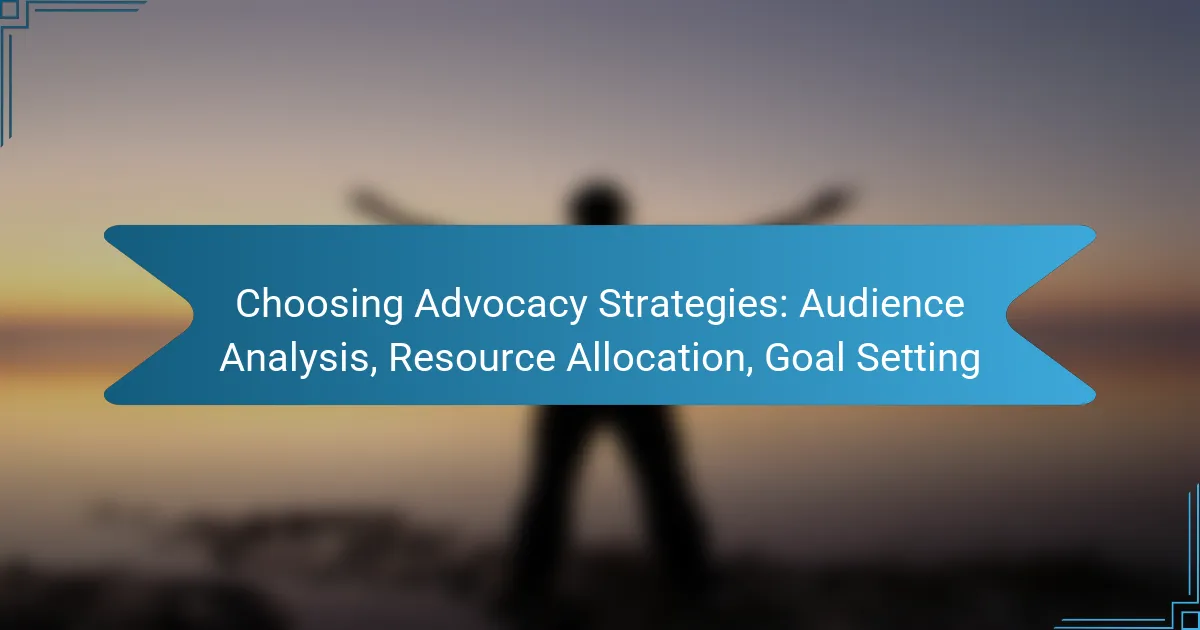Successful advocacy campaigns are powerful tools designed to influence public policy, raise awareness, and drive social change. By employing strategic communication, grassroots mobilization, and digital marketing, these campaigns engage communities and shape decision-making processes. Examining notable case studies reveals effective strategies and outcomes that can serve as inspiration for future advocacy efforts.

What Are Successful Advocacy Campaigns?
Successful advocacy campaigns are organized efforts aimed at influencing public policy, raising awareness, or driving social change. They leverage strategic communication, community engagement, and often a clear set of goals to achieve their objectives.
Definition of advocacy campaigns
Advocacy campaigns are initiatives designed to promote a specific cause or issue, often involving various stakeholders such as individuals, organizations, and communities. These campaigns typically focus on raising awareness, influencing decision-makers, or mobilizing public support to effect change.
They can take many forms, including grassroots movements, lobbying efforts, and public awareness campaigns, each tailored to the specific goals and context of the issue at hand.
Key characteristics of successful campaigns
Successful advocacy campaigns share several key characteristics, including a clear mission, well-defined target audiences, and effective messaging. A strong campaign often utilizes data and storytelling to resonate with its audience, making the issue relatable and urgent.
Additionally, collaboration with partners and stakeholders can amplify the campaign’s reach and impact. Monitoring and adapting strategies based on feedback and outcomes are also crucial for sustained success.
Importance in social change
Advocacy campaigns play a vital role in driving social change by raising awareness about critical issues and mobilizing communities. They can influence legislation, shift public opinion, and bring about systemic changes that improve lives.
For instance, campaigns focused on environmental protection have led to significant policy changes in many countries, highlighting the power of collective action. Engaging diverse groups in advocacy efforts can further enhance their effectiveness and foster a sense of shared responsibility for societal issues.

What Strategies Drive Effective Advocacy Campaigns?
Effective advocacy campaigns rely on a combination of grassroots mobilization, digital marketing, and strategic partnerships. These strategies help to engage supporters, spread awareness, and influence decision-makers.
Grassroots mobilization techniques
Grassroots mobilization involves rallying community members to take action on a specific issue. This can include organizing local events, door-to-door canvassing, and phone banking to encourage participation and raise awareness.
Key steps include identifying target audiences, training volunteers, and creating compelling messaging that resonates with the community. Successful campaigns often utilize social media to amplify their reach and encourage grassroots supporters to share their stories.
Digital marketing strategies
Digital marketing strategies are essential for reaching a broader audience and engaging supporters online. Techniques such as email campaigns, social media advertising, and content marketing can effectively raise awareness and drive action.
Consider using targeted ads to reach specific demographics or using analytics to track engagement and optimize campaigns. A/B testing different messages can also help identify what resonates best with your audience.
Partnerships with organizations
Forming partnerships with other organizations can enhance the impact of advocacy campaigns. Collaborating with groups that share similar goals can provide additional resources, expertise, and networks to amplify your message.
When establishing partnerships, ensure that the organizations align with your values and mission. Joint events, co-branded materials, and shared social media campaigns can help leverage each partner’s strengths for greater outreach.

What Are Notable Case Studies in the UK?
Notable advocacy campaigns in the UK have significantly influenced public policy and social awareness. These case studies illustrate effective strategies and outcomes that can inspire future movements.
Case study: The Climate Coalition
The Climate Coalition is a prominent UK advocacy group focused on addressing climate change through collective action. Formed in 2005, it unites over 100 organizations, including charities, faith groups, and businesses, to campaign for stronger climate policies.
One key strategy of The Climate Coalition is mobilizing public support through events like the annual “Show the Love” campaign, which encourages individuals to express their commitment to climate action. This grassroots approach has successfully engaged thousands, raising awareness and prompting political action.
Case study: Black Lives Matter UK
Black Lives Matter UK (BLM UK) emerged in response to systemic racism and police brutality, aiming to amplify the voices of marginalized communities. Founded in 2016, the movement has utilized social media to raise awareness and organize protests, particularly following high-profile incidents of racial injustice.
BLM UK’s strategies include direct action, community organizing, and educational initiatives. Their campaigns often emphasize the importance of intersectionality, addressing how various forms of discrimination overlap. This approach has fostered a broader dialogue about race and equality in the UK.
Case study: The #MeToo Movement
The #MeToo movement gained traction in the UK as part of a global response to sexual harassment and assault. It encourages survivors to share their experiences, aiming to raise awareness and promote accountability for perpetrators.
In the UK, the movement has led to significant cultural shifts and legislative discussions around workplace harassment. Campaigns often utilize social media to amplify stories and foster solidarity, highlighting the need for systemic change in both public and private sectors.

What Outcomes Can Be Expected from Advocacy Campaigns?
Advocacy campaigns can lead to significant outcomes, including policy changes, increased public awareness, and enhanced community engagement. These results depend on the campaign’s strategy, target audience, and the issues at stake.
Policy changes
One of the primary outcomes of successful advocacy campaigns is the implementation of policy changes. This can involve new legislation, amendments to existing laws, or shifts in regulatory practices. For instance, campaigns focused on environmental issues may lead to stricter emissions regulations or the establishment of protected areas.
To achieve policy changes, advocates should clearly define their goals, gather data to support their claims, and engage with policymakers. Building coalitions with like-minded organizations can amplify their influence and increase the likelihood of success.
Increased public awareness
Advocacy campaigns often aim to raise public awareness about specific issues, which can drive social change. Increased awareness can lead to a more informed public that is capable of engaging in meaningful discussions and advocating for change themselves. For example, campaigns addressing health issues may result in greater understanding of preventive measures and available resources.
Effective strategies for raising awareness include social media campaigns, public events, and partnerships with influential figures. Utilizing storytelling can also resonate with the audience, making the issue more relatable and urgent.
Community engagement
Successful advocacy campaigns foster community engagement by encouraging individuals to participate in discussions and actions related to the cause. This can manifest in various forms, such as attending town hall meetings, participating in rallies, or volunteering for related organizations. Engaged communities are more likely to mobilize and sustain efforts over time.
To enhance community engagement, advocates should focus on building relationships and trust within the community. Providing opportunities for involvement and recognizing contributions can motivate individuals to stay active in the campaign. Regular communication and feedback loops are essential to maintain momentum and adapt strategies as needed.

What Are the Key Metrics for Measuring Success?
Key metrics for measuring the success of advocacy campaigns include engagement rates, policy impact assessments, and funding/resource allocation. These metrics provide a comprehensive view of how effectively a campaign has mobilized support, influenced policy, and utilized resources.
Engagement rates
Engagement rates reflect how actively stakeholders participate in an advocacy campaign. This can include metrics such as social media interactions, email open rates, and event attendance. High engagement rates indicate strong public interest and support, which can amplify the campaign’s reach.
To measure engagement effectively, consider tracking the number of shares, likes, and comments on social media platforms, as well as the percentage of email recipients who take action. Aim for engagement rates that are above industry averages, typically around 1-5% for social media and 20-30% for email campaigns.
Policy impact assessments
Policy impact assessments evaluate the tangible effects of an advocacy campaign on legislation or public policy. This involves analyzing changes in laws, regulations, or government actions that can be directly linked to the campaign’s efforts. Successful campaigns often result in measurable policy shifts that align with their goals.
To conduct a policy impact assessment, gather data on relevant legislative changes, stakeholder responses, and public opinion shifts. Consider using qualitative methods, such as interviews with policymakers, alongside quantitative data to provide a well-rounded view of the campaign’s influence.
Funding and resource allocation
Funding and resource allocation metrics assess how effectively a campaign utilizes its financial and human resources. This includes tracking budget expenditures, fundraising success, and the distribution of resources across various campaign activities. Efficient resource allocation can significantly enhance a campaign’s overall impact.
To optimize funding and resource use, regularly review budget reports and adjust allocations based on campaign needs and performance. Set clear financial goals and monitor fundraising efforts to ensure that resources are directed toward the most impactful strategies. Aim for a balanced approach that maximizes outreach while maintaining fiscal responsibility.

What Are the Challenges in Running Advocacy Campaigns?
Running advocacy campaigns often involves navigating several significant challenges that can hinder effectiveness. Key obstacles include funding limitations and public opposition, both of which require strategic planning and adaptability to overcome.
Funding limitations
Funding limitations can severely restrict the scope and reach of advocacy campaigns. Many organizations rely on donations, grants, or sponsorships, which may not always be reliable or sufficient. It’s crucial to develop a diversified funding strategy that includes multiple sources to ensure sustainability.
Consider setting realistic budget goals and prioritizing essential activities. For instance, campaigns might allocate 40-60% of their budget to outreach efforts, while the remainder could support administrative costs and materials. Engaging in crowdfunding or partnerships with local businesses can also provide additional financial support.
Public opposition
Public opposition can undermine advocacy efforts by creating a hostile environment for the campaign’s message. Understanding the concerns of opposing groups is vital for addressing misconceptions and fostering dialogue. Engaging with the community through forums or surveys can help gauge public sentiment and tailor messages accordingly.
To counteract public opposition, campaigns should focus on building coalitions with like-minded organizations and utilizing social media to amplify their message. It’s beneficial to present clear, factual information and personal stories that resonate with the audience, helping to shift perceptions over time.



